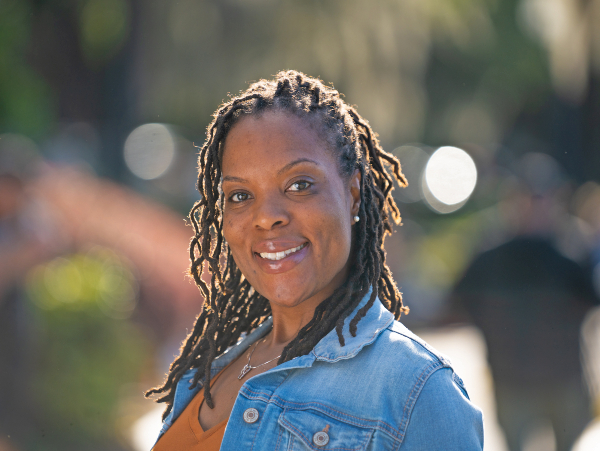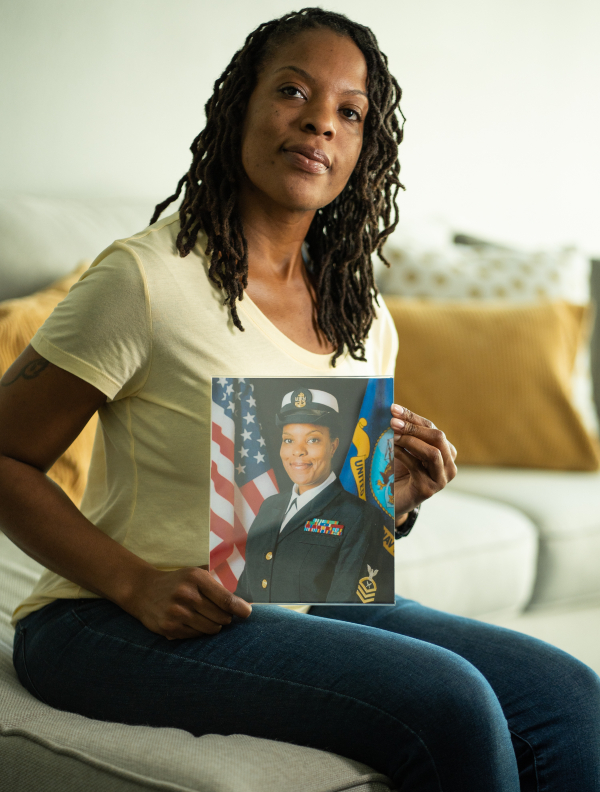Warrior Opens Path to Bright Future while Battling MS

At first, Sharona Young didn’t see herself as a wounded warrior. She had a back injury from falling down a ladder on a ship but didn’t have any other combat injuries. But while on active duty in the Navy, her hands and arms started feeling numb and tingling, and Sharona was eventually diagnosed with multiple sclerosis (MS).
Facing medical retirement in her early 30s, the Navy career she had worked so hard to build seemed to slip from her fingers. But when MS pulled the rug out from under her, Wounded Warrior Project® (WWP) was there for Sharona and her family.
A Life-Changing Diagnosis
Sharona enlisted at 17 years old with the goal of having a long career in the Navy. At the time of her diagnosis, she had a young daughter to provide for and professional goals she wanted to reach. After numerous medical tests and months of wondering what could be wrong, the MS diagnosis brought even more uncertainty.
When Sharona felt the initial symptoms, she chalked it up to using crutches because of a previous surgery. She mentioned it to her doctor anyway. An MRI showed inflammation in her spinal cord and lesions at the base of her brain that indicated MS.
“Not knowing what was going on with my body and not knowing what was going to happen was scary,” Sharona recalled. “The nature of the disease is day to day. Some days I wake up in the morning like, ‘All right, what’s going on today?’ And some days, I can barely move – I can’t get out of bed.”
Watch Sharona’s story in this video.
MS: What Veterans Need to Know
- According to Mayo Clinic, MS is a potentially disabling disease of the brain and spinal cord – the central nervous system – that can make the immune system attack nerve fibers.
- The nerve damage causes mobility issues. Some people lose the ability to walk independently. Others have periods of remission where they regain mobility.
- There’s no cure for MS, but there are treatments that help with recovery from the attacks and to manage the symptoms.
- MS symptoms are unique to every individual and can change or fluctuate over time. Common symptoms include fatigue, walking difficulties, numbness or tingling, and weakness, among others. There are also less common symptoms which include speech problems, tremor, and seizures.
- According to the National MS Society, the number of veterans with MS is on the rise, but only about 40% of veterans with MS receive their care at Veterans Affairs (VA) facilities.
- The U.S. Department of Veterans Affairs established Multiple Sclerosis Centers of Excellence to help veterans with MS attain better quality of life.
An Invisible Enemy
Sharona hesitated to use a wheelchair even when she experienced flare-ups and, for a while, felt like she was battling an invisible enemy alone.
“I went through a period of depression and just feeling isolated and lonely,” Sharona said. “It took a couple of years to adjust to my new normal. In fact, it took a couple of years for me to agree to even get a wheelchair. I had falls and stumbles and wasn’t able to get out of the house and do a lot because of the limited mobility.”
Sharona first heard about WWP while still going through the Navy’s medical board process in Norfolk, Virginia. She also learned about veteran adaptive sports and started with swimming and hand cycling. Through the Navy Safe Harbor Foundation, Sharona experienced adaptive sports for the first time, and was ready to follow-up via WWP’s adaptive sports program.

“I went on a Soldier Ride, which was my first experience with Wounded Warrior Project, and I met great people, including other veterans and the staff, who made me feel comfortable. I was able to say, ‘I can get through this. It’s going to be OK,’” Sharona said.
Through WWP, Sharona’s daughter, Taylor, was also able to connect with other military kids from veteran families going through similar experiences.
“That was really helpful for her, as well,” Sharona added.
The Heartbreak of Medical Retirement
Prior to her symptoms, Sharona was building a great career in the Navy. At her first duty station in Norfolk, she was on board the USS Bataan, an amphibious ship that transported U.S. Marines. She participated in Mediterranean cruises and traveled throughout Europe and the Middle East.
After the diagnosis, Sharona was heartbroken to leave the military.
“I didn’t plan on retiring,” Sharona said. “I had 14½ years in, so I planned to do my full 20, if not more. I felt like I still had more to give. Even though I had the diagnosis, I felt like I could still contribute and provide support to the needs of the Navy. But I was no longer deployable. While I understood that, it was still heartbreaking. I was devastated.”
Building a New, Independent Life
While Sharona’s first activity with WWP was Soldier Ride®, she eventually enrolled in WWP’s Independence Program – although she was skeptical at first.
“I guess when I heard Independence Program, I thought it was for someone who was housebound or someone more severely injured than I was,” Sharona said. “I said to myself, ‘Well, I have all my limbs. I didn’t get blown up. I have a disease, not an injury.’ For the longest time, I just had a hard time even accepting that this program is for me too.”
WWP assists the most severely injured veterans – and their caregivers – through its Independence Program. The veteran’s injury or illness does not have to be combat-related or to have occurred while on active duty. These warriors live with conditions like traumatic brain injury (TBI) and spinal cord injuries, as well as MS, stroke, epilepsy, dementia, Parkinson’s disease, and brain tumors.
The goal of WWP’s Independence Program is to find new avenues for independence for both warrior and caregiver. By working with warriors, families, caregivers, and WWP-provided support, the Independence Program helps craft care plans and goals that fit the individual objectives of each veteran.
The Independence Program offered Sharona support she didn’t know she needed. “Sometimes my Independence Program case manager gives me encouragement, and sometimes they help me remove physical barriers,” Sharona said. “Sometimes she thinks of things that I should be doing that I didn't think of. And it’s been helpful having that person there to help nudge me along and give me the encouragement on the days when I’m not feeling so great or not thinking I can go on. That's been a huge help.”
In addition to physical help, alternative therapies, and occupational therapy that improves mobility, having someone in her corner has helped Sharona feel emotionally supported. When Sharona’s mother passed away in 2022, WWP’s Independence Program stepped in to see what the family needed.
“Just looking at where I’m at now, what I’m going through, it’s just hard to imagine where my daughter and I would be if we didn’t have the support of Wounded Warrior Project and didn’t get connected with the Independence Program,” Sharona said.
“Would I be doing as much as I’m able to do now? Would I be motivated to keep trying to go on and continue to live? So sometimes, I honestly don’t think I would be where I’m at if it wasn’t for Wounded Warrior Project and just meeting the people that I've met. There are no words for it; no comparison for it.”
Planning for a Bright Future
Another aspect of WWP’s Independence Program is continuous care services, which has helped Sharona and Taylor navigate possibilities for the future.
“I’m really appreciative that they’re guiding me and helping me get a plan in place now for myself and for my family, so that we’re prepared for the future,” Sharona said.
Each warrior and family’s needs are unique, and a dedicated case manager works to help each individual thrive and reach their goals at home, in their communities, and in their plans for the future.
First, Sharona was guided through a life-care plan, which recorded her wishes for long-term care. At the same time, WWP is reviewing and helping to optimize her current VA benefits. Sharona will then have the opportunity to meet with a financial planner and an estate planner. All these pieces come together to craft a plan for Sharona’s future care and create stability for her family.
“If I should get to the point where I need to have a caregiver 24 hours a day, I just want to make sure I have a solid plan in place for that,” Sharona said. I don’t want to end up in a situation where I’m in limbo and no one knows what to do with me.”
“Then, with the estate planning, I want to make sure my daughter will be taken care of and that I got those things in place and laid out clearly,” Sharona added. “That’s something that I experienced with my mom’s passing. It was an eye-opener for me. I don’t want Taylor to have to stress figuring out what to do and how to go on.”
Right now, things are looking bright for Sharona. Her daughter is growing up with a wisdom and awareness most young people don’t yet have. Sharona also has her sister, Nakesha, who moved closer to them to help if needed. With WWP’s Independence Program in their corner, the whole family sees a bright path ahead.
“I definitely want to get out and see more of the world,” Sharona said. “I’ve also been learning graphic design and web design, so I’m even thinking about starting my own business doing web design.”
To learn more about WWP’s Independence program and other services available to injured veterans and their caregivers, contact the WWP Resource Center at 888.WWP.ALUM (888.997.2586) or resourcecenter@woundedwarriorproject.org.
Get connected today or read more about how WWP helps. View this video to learn more about WWP’s Independence Program.
Contact: Raquel Rivas – Public Relations, rrivas@woundedwarriorproject.org, 904.426.9783
Watch video | View story in Homeland magazine
About Wounded Warrior Project
Since 2003, Wounded Warrior Project® (WWP) has been meeting the growing needs of warriors, their families, and caregivers — helping them achieve their highest ambition. Learn more.